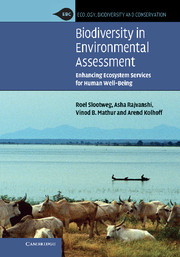Book contents
- Frontmatter
- Contents
- List of contributors
- Foreword
- Preface
- List of abbreviations
- Part I Setting the stage
- 1 Introduction
- 2 Interpretation of biodiversity
- 3 Biodiversity conservation and development: challenges for impact assessment
- Part II Assessment tools
- Part III Emerging issues
- Epilogue – Topics in need of further elaboration
- Annex: valuation of ecosystem services: influential cases
- References
- Index
3 - Biodiversity conservation and development: challenges for impact assessment
Published online by Cambridge University Press: 05 July 2014
- Frontmatter
- Contents
- List of contributors
- Foreword
- Preface
- List of abbreviations
- Part I Setting the stage
- 1 Introduction
- 2 Interpretation of biodiversity
- 3 Biodiversity conservation and development: challenges for impact assessment
- Part II Assessment tools
- Part III Emerging issues
- Epilogue – Topics in need of further elaboration
- Annex: valuation of ecosystem services: influential cases
- References
- Index
Summary
Introduction
The literature linking conservation and development presents a number of different perspectives on the relationship between biodiversity conservation and socioeconomic progress. These differences in perspectives are rooted in the differences in objectives of ‘development’ (which is seen as the intended modification of the biosphere and the application of human, financial, living, and nonliving resources to satisfy human needs and improve the quality of life (IUCN, UNEP, and WWF, 1980)) and of ‘conservation’ (which is generally taken to mean the management of human use of the biosphere through approaches of land use and renewable natural resource management with the objective to yield the greatest sustainable benefits to present and future generations).
Most of the conservation-oriented literature also actually reflects that the local community welfare and development are directly conflicting with the objectives and practice of biodiversity conservation and regard development as the main causal agent of biodiversity loss. According to Sanderson (2002), development and conservation are altogether separate goals as clearly illustrated in his expression:
If development has ignored conservation, conservation has paid too little attention to development. Economic policymakers have concentrated on growth, developers on the distribution of the benefits of growth, and conservationists on the costs and consequences of growth for nature and the environment. The result has been an agreement to disagree, with the growth, development, and conservation communities proceeding down separate paths.
- Type
- Chapter
- Information
- Biodiversity in Environmental AssessmentEnhancing Ecosystem Services for Human Well-Being, pp. 59 - 84Publisher: Cambridge University PressPrint publication year: 2009



